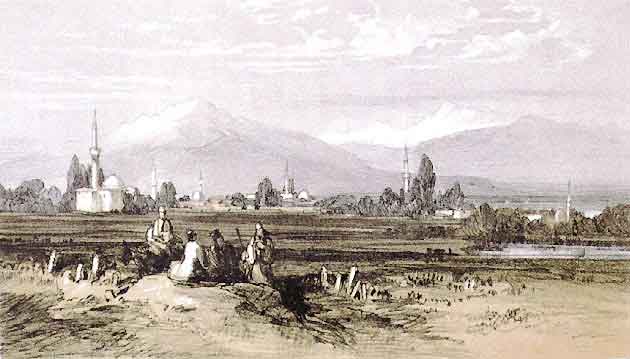.
Administrative Region : Central Macedonia
Regional unit : Pella
Giannitsa (Greek: Γιαννιτσά, in English also Yannitsa, Yenitsa, Yenije, Yenice) is the largest town and a former municipality in Pella regional unit, Greece. Since the 2011 local government reform it is part of the municipality Pella, of which it is the capital.[1] Its chief importance is as an agricultural centre - especially since it is 40 km from Thessaloniki.
The former shallow, swampy, and variable-sized Giannitsa Lake or Loudias Lake (classical), south of the town, was drained in 1928-1932 by the New York Foundation Company.[2] It or the surrounding marshland are sometimes called Borboros 'slime' or Borboros Limen.[3]
Not far from the city are the ruins of ancient Pella, birthplace and capital of Alexander the Great. Giannitsa (then called Yenije) was an important center in the Ottoman period, and several important monuments survive: the tombs of Gazi Evrenos (a 19th-century substitute for the original) and Gazi Ahmed Bey, the Great Mosque, the Army Mosque, the hammam of Evrenos, and the clocktower, which have been declared historical monuments by the Greek Archaeological Service.[4]
The town is home to 26,296 people (2001 census), and its attractions include the annual fair, the "Paniyiri", which runs for two weeks every September.

Name
The city was called Γενιτσά until February 1926 when its name was Hellenized.[5] In other languages, the city is called: Ottoman Turkish Yenice-i Vardar ('new-town of Vardar', as opposed to Yenice-i Karasu, modern Genisea, near Xanthi and known for tobacco), Turkish: Yenice or Vardar Yenicesi, Macedonian: Ениџе Вардар and Bulgarian: Енидже Вардар, Enidže Vardar or Пазар, Pazar.
History
Lithographic drawing of the Battle of Giannitsa.
View of the Catholic Church.
Though there was probably a pre-existing Byzantine castle in the vicinity, the importance of the city of Yenije begins with its foundation by Gazi Evrenos in around 1372. Yenije became the base of the ghazi followers of Evrenos who took Macedonia and later Albania. Yenice was an important Ottoman cultural center in the 15th and 16th centuries.[4]
In the early 20th century, Yenije was a battleground between Bulgarian-Macedonian and Greek-Macedonian partisans in the Struggle for Macedonia. Penelope Delta's Secrets of the Swamp (referring to the shores of Giannitsa Lake) is a romanticised account of this from the Greek point of view.
Yenije "retained its emphatically Turkish character up to 1912" and members of the Evrenos family lived in Yenice in a large palace in the center of town until then. The Greek army captured Yenice after the Battle of Giannitsa in the First Balkan War (1912); part of the town was destroyed by fire.[6]
On 14 September 1944, during the German occupation of Greece, about 120 residents of Giannitsa were executed by forces of the Jagdkommando Schubert and collaborationist Greek units under the command of G. Poulos. Part of the city was also burned.
Notable people
Gazi Evrenos, founder of the Ottoman city, whose mausoleum is in the center of town
Āgehī (died 1577/8), Ottoman poet and historian
Georgios Gonos Giotas, (1880 - 1911) - revolutionary in the Macedonian Struggle

References
^ Kallikratis law Greece Ministry of Interior (Greek)
^ Eugene N. Borza, In the shadow of Olympus: the emergence of Macedon (1992) ISBN 0-691-00880-9, p. 289; Matthieu Ghilardi et al., "Human occupation and geomorphological evolution of the Thessaloniki Plain (Greece) since mid Holocene", Journal of Archaeological Science 35:1:111-125 (January 2008)
^ Ghilardi; Théophile Alphonse Desdevises-du-Dezert, Géographie ancienne de la Macédoine (A. Durand, 1863)
^ a b Vasilis Demetriades, "The Tomb of Ghāzī Evrenos Bey at Yenitsa and Its Inscription", Bulletin of the School of Oriental and African Studies (University of London) 39:2:328-332 (1976); Eleni Kanetaki, "The Still Existing Ottoman Hamams in the Greek Territory", Middle East Technical University Journal of the Faculty of Architecture 21:1-2:81-110 (2005); citing M. Kiel, "Yenice-i Vardar. A forgotten Turkish cultural center in Macedonia of the 15th and 16th century", Studia Byzantina et Neohellenica Neerlandica 3:300-329 (1971)
^ Institute for Neohellenic Research, "Name Changes of Settlements in Greece" Genitsa/Giannitsa
^ Demetriades, p. 329
External links
Official website (Greek)
| Municipal unit Giannitsa |
|---|
| Municipal community Giannitsa |
| Archontiko (Αρχοντικό, το) |
| Asvestareio (Ασβεσταρειό, το) |
| Giannitsa (Γιαννιτσά, τα) |
| Damiano (Δαμιανό, το) |
| Eleftherochori (Ελευθεροχώρι, το) |
| Leptokarya (Λεπτοκαρυά, η) |
| Mesiano (Μεσιανό, το) |
| Paralimni (Παραλίμνη, η) |
| Community Ampeleies |
| Ampeleies (Αμπελείαι, αι) |
| Community Melissi |
| Melissi (Μελίσσι, το) |
Greece :
A - B - C - D - E - F - G - H - I - J - K - L - M -
N - O - P - Q - R - S - T - U - V - W - X - Y - Z
| Ancient Greece
Science, Technology , Medicine , Warfare, , Biographies , Life , Cities/Places/Maps , Arts , Literature , Philosophy ,Olympics, Mythology , History , Images Medieval Greece / Byzantine Empire Science, Technology, Arts, , Warfare , Literature, Biographies, Icons, History Modern Greece Cities, Islands, Regions, Fauna/Flora ,Biographies , History , Warfare, Science/Technology, Literature, Music , Arts , Film/Actors , Sport , Fashion --- |
Retrieved from "http://en.wikipedia.org/"
All text is available under the terms of the GNU Free Documentation License


